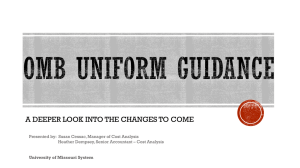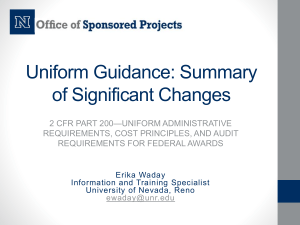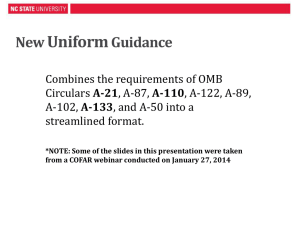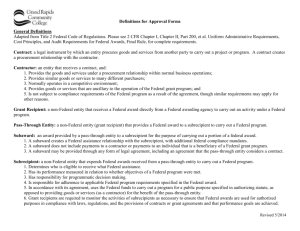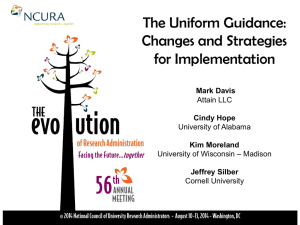Implementing the Uniform Guidance Parts I and II Financial and Business Services
advertisement
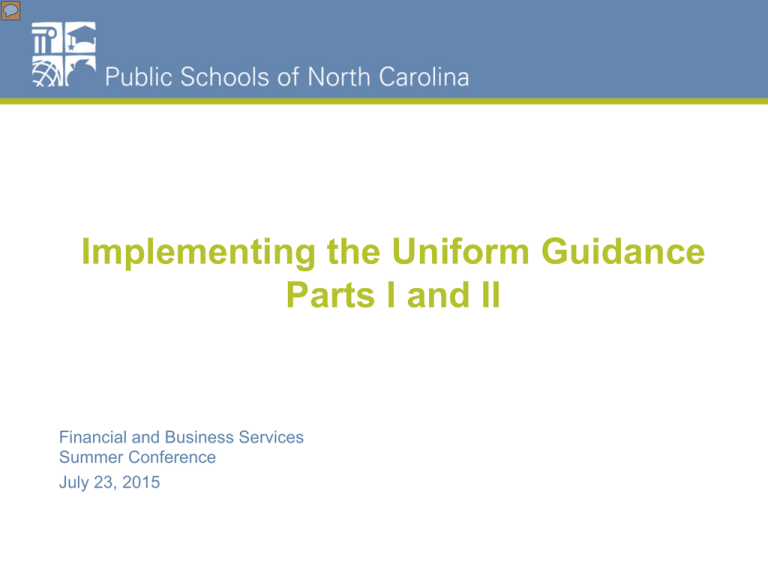
Implementing the Uniform Guidance Parts I and II Financial and Business Services Summer Conference July 23, 2015 Objectives Attendees will gain an understanding of the following: Goals of the Uniform Guidance (2 Code of Federal Regulations (CFR) part 200) Preparation for implementing the guidance Key changes in the guidance Impact of changes on subrecipients Resources for technical assistance and training Uniform Guidance Goals Uniform Administrative Requirements, Cost Principles, and Audit Requirements for Federal Awards Streamline and consolidate eight existing OMB Circulars Reduce administrative burden Remove duplications Remove inconsistencies and conflicting information Improve outcomes Uniform Guidance Goals Support Key Policy Reforms Emphasis on performance Increased flexibility Increased accountability and oversight Efficient use of technology Consistent treatment of costs Standardizing business processes and data definitions Preparation for Uniform Guidance • US Department of Education o Amended guidance and regulations o Office of Management and Budget (OMB) Circulars o Education Department General Administrative Regulations (EDGAR) o Code of Federal Regulations (CFR) o Developed Technical Assistance webpage and email o http://www2.ed.gov/policy/fund/guid/uniform-guidance/index.html o FAQs o OMB developed training o ED developed training o Crosswalks o UniformGrantGuidanceImplementation@ed.gov Preparation for Uniform Guidance North Carolina Department of Public Instruction Analyzing new EDGAR Revising policies and procedures Developing information related to changes in regulatory governance Finance Officer Newsletter Webpage Templates and Guides Presentations and training sessions Frequently Asked Questions (FAQ) Statutes, Regulations and Guidance • Federal Statutes • Congress passes and creates a federal education program or rule • Types of statutes • Programmatic (NCLB, IDEA) • Administrative (Cross-cutting) • Appropriation (specific amount of money for specific program) • Regulations • Federal agency drafts and adopts to implement statute • Types of regulations • Programmatic (NCLB, IDEA) • Administrative (EDGAR) • Nonregulatory Guidance and Policy • Agency interpretation of statutes and regulations • Not same legal authority as statute or regulations Federal Grants Management under Uniform Guidance KEY CHANGES 1. Focus on outcomes 6. Micro Purchases 2. Performance Metrics 7. Corrective Action 3. Risk Assessments 8. Family Friendly Policies 4. Financial Management Policies 9. False Claim Certifications 5. Equipment Use 10. Audit Thresholds Uniform Grants Guidance - Timeline Changes took effect when the next fiscal year after December 26, 2014 started – so July 1, 2015 for audit and indirect costs purposes. Uniform guidance applies to funds carried over in Stateadministered and formula programs from FY 2015 to FY 2016 (on 10/1/15) and to funds carried over in discretionary programs in continuation awards made on or after December 26, 2014. Example: A State-administered grant was awarded on July 1, 2014 has existing terms/conditions (based on former part 80). If any of those funds are unobligated and carried over to FY 2016 (on 10/1/15), they will have to be used and accounted for consistent with the new Uniform Guidance. In general, by October 1, 2015, most discretionary and formula grants will be following the Uniform Guidance. Structure of Uniform Guidance Organized to align with grant life cycle Sub-parts A – Acronyms and Definitions B – General Provisions C – Pre-Award Requirements D – Post-Award Requirements E – Cost Principles F – Audit Requirements Appendices III-V and VII – Indirect Cost / Cost Allocation Plans XI – Compliance Supplement Crosswalk to Uniform Guidance Grants made before December 26, 2014 Grants made on or after December 26, 2014 Circulars A-89. A-102, and A-110 Uniform Guidance Subparts B, C, and D Circulars A-21, A-87 and A-122 Uniform Guidance Subpart E Circulars A-133 and A-50 Uniform Guidance Subpart F EDGAR Parts 75-99 EDGAR Parts 75-79 and 81-89 EDGAR Parts 74 and 80 Incorporated in Uniform Guidance Uniform Guidance Subpart A – Acronyms and Definitions 200.74 - Pass-through entity Non-Federal entity that provides a subaward to a subrecipient to carry out part of a Federal program. 200.93 - Subrecipient Non-Federal entity that receives a subaward from a passthrough entity to carry out part of a Federal program. 200.23 - Contractor (replaces term “vendor” (used in A-133)) An entity that receives a contract. Uniform Guidance Subpart A – Acronyms and Definitions 200.25 - Cooperative Audit Resolution Use of audit follow-up techniques which promote prompt corrective action by improving communication, fostering collaboration, promoting trust and developing an understanding between the Federal agency and the non-Federal entity. 200.28 – Cost Objectives Program function, activity, award, organizational subdivision, contract, or work unit for which cost data are desired and for which provision is made to accumulate and measure the cost of processes, products, jobs, capital projects, etc. Uniform Guidance Subpart A – Acronyms and Definitions 200.33 – Equipment Tangible, nonexpendable, personal property having a useful life of more than one year and an acquisition cost of $5,000 or more per unit. 200.61 – Internal Controls A process, implemented by a non-Federal entity, designed to provide reasonable assurance regarding the achievement of objectives in the following categories: Effectiveness and efficiency of operations Reliability of reporting for internal and external use, and Compliance with applicable laws and regulations. Uniform Guidance Subpart A – Acronyms and Definitions 200.94 – Supplies All tangible property other than equipment. Computing devices are supplies if less than $5,000 NEW 200.20 –Computing devices NEW Machines used to acquire, store, analyze, process, public data and other information electronically. Includes accessories for printing, transmitting and receiving or storing electronic information. Uniform Guidance Subpart B – General Provisions SUBPART B - GENERAL PROVISIONS 200.11 - Conflict of Interest USDE must establish conflict of interest policies for Federal awards 200.113 - Mandatory Disclosures Non-Federal entities must disclose in writing in a timely manner all violations of Federal criminal law involving fraud, bribery, or gratuity violations potentially affecting the Federal award Failure to make disclosures can All non-federal entities must establish conflict of interest result in remedies for noncompliance (200.338) policies and disclose in writing any potential conflict of interest to the federal awarding agency in accordance with the new Federal awarding agency policy Uniform Guidance - Federal Requirements and Contents of Awards Type of Grant Agreement Nature of Funding Financial Management Rules Identification of Awards Financial Reporting Risk Assessments Specific Conditions Monitoring Performance Metrics Cost Principles Audit Resolution Enforcement Remedies for Noncompliance Uniform Guidance – Type of Grant Agreement 200.201 – NEW Pass-through entity must decide on the appropriate instrument for the Federal Award: Grant agreement Cooperative agreement Contract Uniform Guidance – Fixed Amount Awards 200.332 and 200.45 - NEW Requires prior approval from Federal awarding agency Payments are based on meeting specific requirements of the Federal Award Accountability is based on performance and results Award amount is negotiated using cost principles as a guide (Up to Simplified Acquisition Threshold (currently $150,000)) No governmental review of the actual costs incurred Significant changes (i.e., principal investigator, project partner or scope) must receive prior awarding agency written approval Uniform Guidance – Nature of Funding 200.300 – Determination of Nature of Funding A Pass-through entity must make a case-by-case determination as to whether each agreement casts the party as a subrecipient or contractor. Look at the nature of the relationship. Subaward Contract Allowable activities based on applicable statute, local plan, and State rules Allowable activities based on terms and conditions of contract. Management rules are applicable OMB circular and State law, policies and procedures Management rules include terms of contract and State contract law. Uniform Guidance – Nature of Funding 200.330(a) – Subrecipient Determines who is eligible to participate in a federal program Has its performance measured against whether the objectives of the federal program are met Is responsible for programmatic decision making Is responsible for complying with federal program requirements Uses the federal funds to carry out a program as compared to providing goods or services for a program Uniform Guidance – Nature of Funding 200.330(b) – Contractor Provides the goods and services within normal business operations Provides similar goods or services to many different purchasers Operates in a competitive environment Provides goods or services that are ancillary to the operation of the federal program Is not subject to compliance requirements of the federal program Uniform Guidance – Financial Management Rules 200.302(b) - Financial Management Rules Identification of Awards NEW Financial Reporting Accounting Records Internal Control Budget Control Written Cash Management Procedures NEW Written Allowability Procedures NEW Uniform Guidance – Identification of Awards 200.331(a) – NEW All pass-through entities must ensure subawards are clearly identified with specific data: 1. Subrecipient name (must match the name associated with its unique entity identifier) 2. Subrecipient unique entity identifier 3. Federal Award Identification Number (FAIN) 4. Federal Award Date 5. Period of performance start and end date 6. Amount of federal funds ‘obligated by this action’ 7. Total amount of federal funds ‘obligated to the subrecipient’ Uniform Guidance – Identification of Awards 200.331(a) – NEW All pass-through entities must ensure subawards are clearly identified with specific data (continued): 8. Total amount of the federal award 9. Federal award project description for FFATA purposes 10. Name of federal awarding agency, pass-through entity, and contact official 11. CFDA Number and Name; the pass-through entity must identify the dollar amount made available under each Federal award and the CFDA number at time of disbursement 12. Whether the award is for “research and development” 13. The indirect cost rate Uniform Guidance – Content of Awards 200.331(a) – The pass-through entity must reference: The requirements of the federal grant and any additional requirements imposed by the pass-through (e.g., identification of any required financial and performance reports) An approved federally recognized indirect cost rate negotiated between the subrecipient and the Federal Government Appropriate terms and conditions concerning closeout of the subaward Uniform Guidance – Financial Reporting Accurate, current, complete disclosure of financial results of each award. 200.327 – NEW Federal awarding agency can only collect OMB approved data elements, no less than annually, no more than quarterly. 200.328 – NEW Non-federal entity must submit performance reports at intervals required by federal agency or pass-through entity. Uniform Guidance – Accounting Records Source documentation must be kept on: Federal Awards Authorizations Obligations and Unobligated balances Assets Expenditures Income Interest NEW Electronic records NEW Unalterable original electronic records eliminate need for creation and retention of paper copies (200.335) Electronic records may be substituted for original paper records Uniform Guidance – Risk Assessment 200.205 – NEW Federal Award Agency Review of Risk Posed by Applicants Must have framework for evaluating risks posed by applicants; which may include reviewing the following: Financial stability Quality of management system History of Performance Audit Reports Applicant’s ability to effectively implement program Uniform Guidance – Risk Assessment 200.331(b) – NEW Evaluate subrecipient’s risk of noncompliance for the purpose of determining appropriate monitoring actions. Prior experience with same or similar subawards Results of previous audits Change in personnel or new/substantially changed systems Extent and results of Federal monitoring Uniform Guidance – Specific Conditions 200.207(a) – Specific Conditions Federal agency or pass-through entity may consider imposing additional conditions on Federal awards: Require reimbursement Withhold authority to proceed until evidence of effective performance Require additional detailed reporting Perform project monitoring Require grantee obtain technical or management assistance Establish additional prior approvals Uniform Guidance – Specific Conditions 200.207(b-c) – Specific Conditions Right to Notice: Nature of additional requirements Reason why imposed Nature of action needed to remove requirements Time for completing actions Method for requesting reconsideration Specific conditions must be removed once corrected Uniform Guidance - Performance Metrics Financial Reporting: Accurate, current, complete disclosure of financial results of each award. 200.328(b)(2) - NEW Performance Metrics 1. Compare actual accomplishments to objectives 2. Provide reasons goals not met if appropriate 3. Additional pertinent information including, when appropriate, analysis and explanation of cost overruns or high unit costs 4. Significant developments, problems, delays, adverse conditions 5. Favorable developments Uniform Guidance – Monitoring 200.331(d) – Monitoring to ensure subaward is used for authorized purposes, including: Review of financial and performance reports Issue management decisions for audit findings Ensure timely and appropriate corrective action for all deficiencies, 200.331(d)(2) - Use monitoring to ensure appropriate action is taken, through: Audits On-Site Reviews Other means Uniform Guidance – Monitoring Tools 200.331(e) - Depending on assessment of risk, the following monitoring tools may be useful for the passthrough entity to ensure proper accountability and compliance with program requirements and achievement of performance goals: Training and technical assistance On-site monitoring or desk reviews Arranging for “agreed-upon-procedures” engagements (described in 200.425 Audit Services) Uniform Guidance – Cost Principles Cost Principles: Notable Changes New requirement - 200.407 - Certifications required for fiscal reports, payment requests, and indirect cost proposals. Family-friendly flexibility Limited dependent care costs at conferences and travel Clarification – Materials and supplies Uniform Guidance – Cost Principles 200.407 - NEW Prior written approval in order to avoid subsequent disallowances Cognizant agency for indirect cost Federal awarding agency in advance of incurrence of special or unusual costs 200.413 - NEW – Direct vs Indirect Costs Salaries of administrative and clerical staff must be treated as “indirect” unless all of following are met: Services integral to activity Individual specifically identified with activity Explicitly included in budget Not recovered as indirect Uniform Guidance – Cost Principles 200.410 - NEW Collection of Unallowable Costs Payments made for costs determined to be unallowable by either the Federal awarding agency or the pass-through entity must be refunded (including interest) to the Federal government in accordance with instructions from the Federal agency that determine costs are unallowable 200.432 - NEW – Conferences Costs related to identifying, but not providing, locally available dependent-care resources Uniform Guidance – Cost Principles 200.438 – NEW Entertainment unallowable: Except where costs might otherwise by considered programmatic and are authorized or have prior written approval of the Federal awarding agency 200.474 - NEW Travel costs Travel charges must be consistent with entity’s written travel reimbursement policies Allows costs for “above and beyond regular dependent care” Travel costs must be reasonable and consistent with written travel policy / or follow GSA 48 CFR 31.205-46(a) Uniform Guidance – Cost Principles 200.430(i)(1) - NEW – Documentation for Personnel Expenses Must be supported by a system of internal controls which provides reasonable assurance charges are accurate, allowable and properly allocated Must be incorporated into official records Must reasonably reflect total activity for which employee is compensated Must encompass all federal and non-federal activity Comply with established accounting policies and practices Support distribution among specific activities or cost objectives Uniform Guidance – Cost Principles 200.430(i)(1) - NEW – Personnel Expenses Percentages May reflect categories of activities expressed as a percentage distribution of total activities 200.430(i) - NEW – Personnel Expenses Compliance For records which meet the standards, the non-Federal entity is not required to provide additional support or documentation for the work performed PARS are not defined in the regulations 200.430(i) - NEW – Personnel Expenses Reconciliation All necessary adjustment must be made such that the final amount charged to the Federal award is accurate, allowable and properly allocated Uniform Guidance – Indirect Costs Key changes in Indirect Costs Flexibility for grantees that have never had negotiated indirect cost rate: de minimis rate of 10% Modified Total Direct Costs (MTDC) States and LEAs not eligible Not for training grants Does not supersede individual grant indirect cost limitations Flexibility: Grantees with negotiated rate may apply for an extension up to four years Reduce requirement to negotiate annually Requests for extension must be submitted 60 days earlier than due date for indirect cost proposals (4 months after fiscal year end) Uniform Guidance – Audit Resolution 200.331(e) – NEW Audit Resolution: Verify subrecipients have audits as required in Subpart F Audit threshold raised from $500K (A-133 circular) to $750K (uniform grant guidance) Questioned costs less than $25,000 are no longer required to be reported. Places greater burden on pass-through 200.331(g) – NEW Pass-through entity must consider whether results of audits or monitoring require adjustments to the pass-through entity's own records Uniform Guidance – Audit Resolution 200.512 - NEW Single audit report submission: All auditees must submit reporting package and data collection form electronically to the Federal Audit Clearinghouse (FAC) 200.516 – NEW Known questioned costs greater than $25,000 for “non-major” programs as well 200.513 – NEW Federal awarding agency must use the cooperative audit resolution (CAROI) to improve Federal program outcomes Uniform Guidance – Enforcement Action 200.331(h) - Consider taking enforcement action based on noncompliance, including: Temporarily withholding cash payments pending correction Disallowing all or part of the cost Wholly or partly suspending the award Recommending suspension/debarment to federal awarding agency Withholding further federal awards Other remedies that may be legally available Uniform Guidance - Noncompliance 200.338 – Remedies for Noncompliance NEW If noncompliance cannot be remedied through Specific Conditions, the pass-through entity may take one or more of the following actions: Temporarily withhold cash payment pending correction Disallow all or part of the cost Wholly or partly suspend the Federal award Terminate the award for “cause” (200.339) with notice and opportunity for hearing (200.340 and 200.341) Initiate suspension or debarment (2 CFR Part 180) Withhold further Federal awards for the program Take other remedies as legally available Uniform Guidance – Internal Control Oversight responsibility for subrecipient monitoring is tied very closely to internal controls that nonfederal entities, including pass-through entities, are required to have in place. This includes having: Well-trained and knowledgeable staff members; Sufficient resources (financial and staffing) dedicated to subrecipient monitoring; Oversight managers with knowledge to identify the most appropriate methods/tools and extent of monitoring to be used (§200.331(e)(1)); Uniform Guidance – Internal Control Internal Controls – Pass-through entities: Indicators to help identify risks from outside factors that may affect a subrecipient’s performance (those related to economic conditions, political changes, regulatory changes or unreliable information) (§200.331(b)) Official written policies and procedures (e.g., methodology for resolving findings of noncompliance or internal control weaknesses) (§§200.303; 200.331(e)); Follow-up processes to ensure timely appropriate actions are taken or completed on a subrecipient’s reported deficiencies (§200.331(d)(2)); and Reviews of the subrecipient’s financial and programmatic reports (§200.331(d)(1)). Uniform Guidance – Equipment 200.313 – NEW changes: Conditional title vests with non-Federal entity Cannot encumber property without approval of Federal awarding agency or pass-through entity May use equipment to be replaced as a trade-in or sell the property and use proceeds to offset cost of replacement property Must request disposition instructions from Federal agency if required by the terms of the grant; otherwise may be retained, sold or otherwise disposed of as follows: Over $5,000 – pay federal share Under $5,000 – no accountability other than formally dispose Uniform Guidance – Procurement 200.320 – Methods of Procurement: NEW Micro-purchase Acquisition of supplies and services $3,000 or less $2,000 for construction subject to Davis-Bacon Act May be awarded without soliciting competitive quotations if non-Federal entity considers the cost reasonable Must distribute micro-purchases equally among qualified suppliers to the extent practicable Small purchase procedures Uniform Guidance – Procurement 200.320 – Methods of Procurement (continued): Competitive sealed bids Competitive proposals NEW Noncompetitive proposals (200.320(f)) Only appropriate when: The item is only available from a single source There is a public emergency that will not permit delay NEW Federal awarding agency or pass-through entity expressly authorizes noncompetitive proposals in response to a written request from non-Federal entity; or after soliciting a number of sources, competition is determined inadequate. Uniform Guidance – Contract Cost and Price 200.323 – NEW Cost / Price Analysis Must perform a cost or price analysis with every procurement over $150,000, including contract modifications Cost analysis – generally means evaluating the separate cost elements that make up the total price, including profit. Price analysis – generally means evaluating the total price Independent estimate before receiving bids or proposals Uniform Guidance – Budget Control 200.308 – Revision of budget and program plans Report deviations from budget or project scope/objectives Must specifically request prior approval from Federal awarding agency if the following occurs: Change in scope or objective of the project or plan Change in key person specified in application for Federal award Disengagement from project for more than three months or 25 percent reduction in time devoted to the project. Inclusion, unless waived by the Federal awarding agency, of costs that require prior approval under selected items of cost in Subpart E Transfer of funds budgeted to “participant support costs” to other expense categories Uniform Guidance – Budget Control 200.308 – Revision of budget and program plans (continued) Must specifically request prior approval from Federal awarding agency if the following occurs: Subawarding, transferring or contracting work under a Federal award, unless described in the application and funded in the original award Changes in the approved cost-sharing or matching provided by the non-Federal entity Need arises for additional Federal funds to complete the project Uniform Guidance – Waivers 200.308(d) – Waivers can authorize recipients to: Incur costs 90 days before the award Incurred at risk of the recipient Not reimbursed if award not granted Extend period of performance by up to 12 months without prior approval unless: Terms and conditions of the award prohibit Extension requires additional Federal Funds Extension involves change in approved objectives/scope Uniform Guidance – Period of Performance 200.309 – Non-Federal entity may charge to Federal award only allowable costs incurred: During period of performance Before Federal agency or pass-through entity makes award if costs authorized Period of performance length depends on type of grant: State-Administered – “Tydings” Period Direct Grants – “Expanded Authorities” Doctrine Uniform Guidance – Cash Management 200.305 – NEW Written Procedures to implement the requirements of 200.305 Must describe whether non-Federal entity uses: Advance payments Reimbursement Working Capital Advance States – payments governed by Treasury-State CMIA Agreements 31 CFR Part 205 (no change) All other non-Federal entities – payments must minimize time elapsing between draw from G5 and disbursement (not obligation) Uniform Guidance – Cash Management 200.305 – NEW Advances must be maintained in insured accounts 200.305 – NEW Pass-through entities cannot require separate depository accounts 200.305 – NEW Accounts must be interest bearing unless: Aggregate federal awards under $120,000 Account not expected to earn more than $500 per year Bank required minimum balance so high, account not feasible Foreign government or banking system prohibits interest bearing accounts Uniform Guidance – Cash Management 200.305 – NEW Interest up to $500 annually may be retained by non-Federal entity for administrative purposes 200.305 – NEW Interest earned must be remitted annually to HHS Payment Management system Uniform Guidance – Appendix II(H) Debarment and Suspension: Per the Code of Federal Regulations, 2 CFR 200.12, “Nonfederal entities and contractors are subject to the nonprocurement debarment and suspension regulations implementing Executive Orders 12549 and 12689, 2 CFR part 180. The regulations restrict awards, subawards, and contracts with certain parties that are debarred, suspended, or otherwise excluded from or ineligible for participation in Federal assistance programs or activities.” Federal Information Resources US Department of Education EDGAR web page at ed.gov Council on Financial Assistance and Reform (COFAR) at cfo.gov/cofar OMB Policy Statements on Uniform Grant Guidance at http://www.whitehouse.gov/omb/grants_docs Contact Information • Leigh Ann Kerr, Assistant Director, School Business Services; LeighAnn.Kerr@dpi.nc.nc.gov ; (919) 807-3553 • Kathy Cooper, Section Chief, Monitoring and Compliance; Kathy.Cooper@dpi.nc.gov; (919) 807-3664 • Karen Frazier, Fiscal Monitor; Karen.Frazier@dpi.nc.gov ; (919) 807 - 3738 • Gene Bruton, Accountant (Single Audit, DUNS/SAM, Certification); Gene.Bruton@dpi.nc.gov ; (919) 807-3726 • Pam Hill, Fiscal Monitor; Pamela.Hill@dpi.nc.gov; (919) 807-3682
